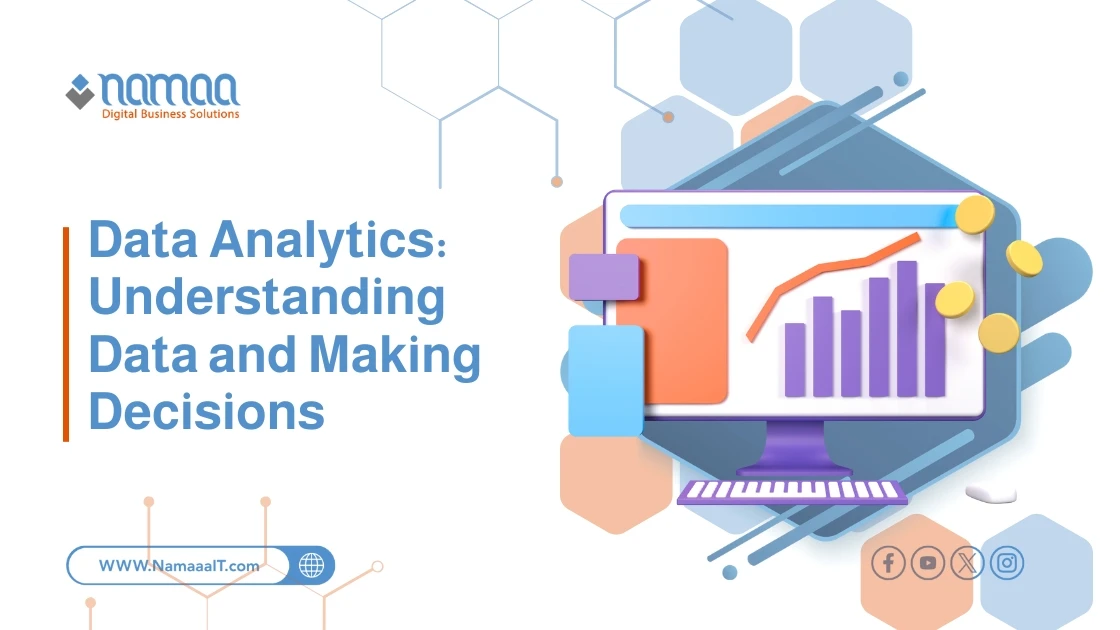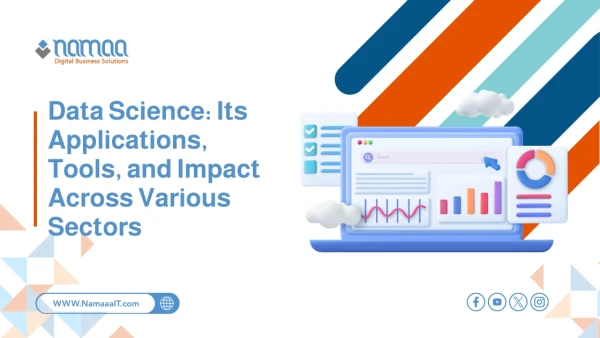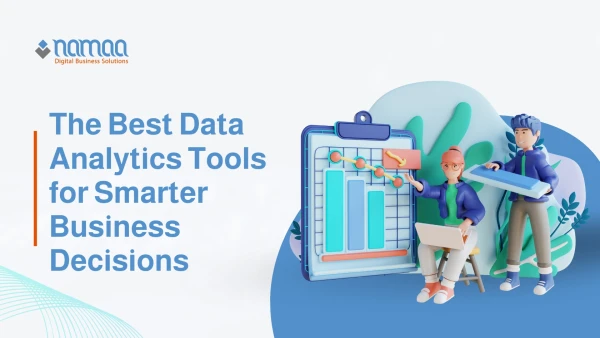Data Analytics has become a fundamental pillar that companies rely on to understand reality and make accurate strategic decisions.
By analyzing raw data, actionable insights can be extracted to improve efficiency, discover opportunities, and prevent risks before they occur. This field goes beyond just reviewing numbers — it also involves advanced techniques like Predictive Modeling and Machine Learning, which enable forecasting future behavior and responding to it flexibly.
Whether the goal is to improve customer experience, enhance the supply chain, or support marketing operations, data analytics provides deeper insights into hidden patterns and relationships within vast amounts of information.
What is Data Analytics?
Data Analytics is a systematic process of analyzing large datasets to uncover patterns, relationships, and trends that can be leveraged to make better decisions.
This process relies on statistical methods, software tools, and advanced computational techniques to understand what the data is telling us.
Data analytics is not limited to numerical tables; it also includes unstructured data like text, images, and audio files. In practice, data analytics typically involves several stages: Data Collection, Data Cleaning, Data Analysis, and Interpretation.
Today, data analytics is used across industries: in retail to analyze purchasing behavior, in healthcare to predict chronic diseases, and in manufacturing to improve efficiency.
Companies that master the use of data gain a real competitive advantage, as they base their decisions on data-driven facts rather than intuition.
Moreover, data analytics has become a key component of Digital Transformation initiatives, making it a necessity rather than a luxury in today’s rapidly changing world.
Types of Data Analytics
Data analytics is divided into four main types, each serving a different purpose depending on the nature of the question asked:
Descriptive Analytics: Answers what happened? It summarizes historical data, such as monthly sales reports or website interaction rates.
Diagnostic Analytics: Answers why did it happen? It connects variables and analyzes causes, such as identifying why sales dropped in a specific region.
Predictive Analytics: Uses statistical models and machine learning algorithms to forecast what might happen in the future, such as predicting customer behavior or employee turnover.
Prescriptive Analytics: Helps determine the best course of action by simulating different scenarios and suggesting recommendations, such as choosing the optimal pricing strategy.
Using these four types in an integrated manner helps companies build a comprehensive view — from understanding the past to controlling the future — turning data into actionable plans.
Learn More: Business Insights
The Importance of Data Analytics in Business Decision-Making
Data analytics is no longer optional in the business world; it has become an integral part of decision-making processes.
Decisions that once relied solely on personal experience or intuition are now driven by digital evidence.
Through data analytics, companies can evaluate marketing campaign effectiveness, measure customer satisfaction, optimize supply chains, and even predict market behavior changes.
For example, a sales department can use data to identify seasonal buying patterns and adjust marketing plans accordingly.
Performance data analysis also improves productivity and reduces costs.
Data analytics enhances the ability to respond quickly to changes, known as Real-Time Insights, allowing decisions to be adjusted during execution, not after.
Interactive data dashboards also enable managers to continuously monitor Key Performance Indicators (KPIs).
Ultimately, companies that rely on data are more adaptable, make less risky decisions, and base their strategies on reality.
Data Analytics Tools
Today, a wide range of tools support data analytics, with the most prominent being Excel, Python, and R.
Each tool has its strengths and limitations depending on the type of analysis and the required technical skills.
Excel is the most commonly used due to its ease and wide adoption, ideal for descriptive analytics, simple table analysis, and visualizations.
When dealing with massive datasets or more complex analytics, Excel becomes insufficient.
This is where Python shines — a versatile programming language supported by powerful libraries like Pandas, NumPy, and Scikit-learn.
Python is suitable for predictive analytics, building statistical models, and machine learning.
R, on the other hand, specializes in statistical analysis and offers strong visualization libraries like ggplot2. It is favored by researchers and academics.
R is more efficient than Python for pure statistical analysis, but Python is superior in building complex models and integrating with other systems.
Choosing between these tools depends on data size, the type of analysis, and the skills available within the team. In many cases, they are even used together to achieve the best results.
Data Analytics in Marketing
Data Analytics has become the most crucial tool for understanding customer behavior and accurately targeting advertising messages.
Instead of launching random marketing campaigns, data allows marketers to know who the customer is, when they interact, and what they prefer.
Using analytics tools like Google Analytics or CRM systems, it's possible to track the customer's journey from seeing an ad to completing a purchase.
Metrics such as Click-Through Rate (CTR), Conversion Rate, and Time on Site can be analyzed to measure campaign effectiveness.
Moreover, Predictive Analytics helps forecast future purchasing behaviors, allowing companies to direct promotional offers with higher precision.
Sentiment Analysis via social media helps understand public impressions about a product or service.
Data-driven marketing not only increases response rates but also reduces ineffective spending and allocates resources more efficiently, making every marketing campaign smarter and more impactful.
Data Analytics in Logistics
In logistics, where precision and efficiency are critical, Data Analytics plays a vital role in optimizing Supply Chain operations.
By tracking the flow of goods and associated data, companies can cut costs, reduce waste, and increase operational efficiency.
For example, data analytics helps in Demand Forecasting, enabling precise inventory planning and avoiding stockouts or overstocking.
Real-Time Monitoring of shipments and warehouses minimizes delays and enables quicker responses to disruptions or challenges.
Predictive analytics can also identify regions most prone to delays or malfunctions, enabling preventive actions.
Additionally, data analytics can be used to select the best suppliers based on efficiency and price and optimize transportation routes to reduce costs and fuel consumption.
Advanced analytics are also becoming a core tool in implementing Smart Logistics concepts, where data is integrated with IoT systems and smart devices to boost performance.
Companies investing in supply chain analytics gain a high competitive advantage and deliver better service to customers.
Data Analytics in E-commerce
In the highly competitive E-commerce environment, Data Analytics is the key to excelling at delivering a personalized user experience.
By tracking customer behavior on the site — such as products viewed, items added to cart, and previous purchases — a digital profile for each user can be created.
This file is used to deliver accurate Product Recommendations, display personalized discounts, and even adjust the website interface to match customer preferences. This type of personalization relies on Machine Learning techniques and pattern analysis. For example, if a customer prefers eco-friendly products, the website will display content and products aligned with this preference.
Analytics also help in understanding drop-off points during the user journey, such as the stages where customers leave the website without completing a purchase, enabling the improvement of the user experience and reducing the cart abandonment rate. Additionally, data allows companies to understand the factors influencing customer loyalty and retention. Ultimately, personalization through data analytics not only boosts sales but also enhances the user experience and builds a stronger relationship between the customer and the brand.
Data Analytics in Cybersecurity
Cybersecurity increasingly relies on Data Analytics to detect and respond to digital threats in real time. With the rise of cyberattacks, traditional solutions are no longer sufficient. Data analytics is used to detect unusual patterns in networks or user behavior, such as suspicious login attempts or irregular file downloads.
Organizations depend on predictive analytics to detect attacks before they occur by analyzing log data, network traffic, and user behavior analytics. Tools like SIEM (Security Information and Event Management) use real-time data analysis algorithms to distinguish real alerts from false ones.
These analytics can also be integrated with artificial intelligence technologies to enhance response accuracy and protection effectiveness. Moreover, data helps in post-attack analysis to understand vulnerabilities and improve security policies. Through this data-driven approach, organizations can not only defend against attacks but also predict them, making cybersecurity more effective and proactive.
Summary:
✔️ Data-driven companies grow their revenues 5–6% faster.
✔️ 52% of large companies use predictive analytics in their operational plans.
✔️ Descriptive analytics explains what happened, diagnostic analytics explains why, predictive analytics tells what will happen, and prescriptive analytics suggests what should be done.
✔️ Data-driven companies outperform their competitors by 3x.
✔️ 70% of organizations believe data analytics is essential for innovation.
✔️ Excel is suitable for simple analytics but limited with big data.
✔️ Python is the preferred tool for 60% of data scientists.
✔️ R excels in precise statistical analyses and advanced visualizations.
✔️ Personalized marketing through data boosts effectiveness by 25–30%.
✔️ Analyzing customer behavior helps predict purchases and tailor offers.
✔️ 79% of leading logistics companies rely on data analytics.






.webp)


